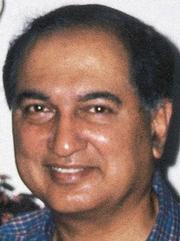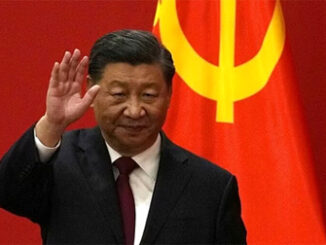

“Though Pakistan has not enunciated a formal nuclear doctrine, its then head of strategic planning division of its nuclear command authority, Lt-Gen Khalid Kidwai, had averred that Pakistan’s nuclear weapons were “aimed solely at India”. Kidwai added that Pakistan would use nuclear weapons if India conquers a large part of Pakistani territory, or destroys a large part of its land and air forces. Kidwai also held out the possibility of using nuclear weapons if India tries to “economically strangulate” Pakistan, or pushes it to political destabilization”, says the author.
Led by the US and Soviet Union, the five Permanent Members of the UN Security Council tried to ensure, some five decades ago, that they alone had the divine right to possess nuclear weapons in perpetuity, with the signing of the nuclear Non-Proliferation Treaty (NPT). Their nuclear arsenals steadily increased and pleas for nuclear disarmament arrogantly disregarded. The world nuclear scenario today is now different to what the five envisaged. Nuclear stockpiles have steadily grown. In the past few decades, Israel, Pakistan, India and North Korea have joined the “nuclear club”. Others like Japan and Iran are capable of doing so when needed. There are an estimated 14,900 nuclear warheads in nine countries, with 93 per cent of these in the possession of the US and Russia.
While China tested and acquired nuclear weapons in the 1960s, the next country to acquire nuclear weapons was Pakistan, which commenced its quest for nuclear weapons after the 1971 Bangladesh conflict. India crossed the nuclear threshold only after it received a veiled nuclear threat from Pakistan during tensions over military exercises named “Operation Brasstacks” in January 1987. Instructions were issued in 1988 to nuclear scientist PK Iyengar and scientific adviser VS Arunachalam to assemble a nuclear arsenal. India’s distinguished strategic thinker, K Subrahmanyam, provided the strategic rationale for the nuclear weapons program. India decisively demonstrated its nuclear weapons capabilities 10 years later, with the Pokhran tests. Pakistan predictably followed suit, barely a fortnight later.
India is today confronted with a situation where China has not only provided Pakistan with designs and equipment for manufacturing nuclear weapons, but has also given Pakistan the knowhow and materials for manufacturing missiles capable of carrying nuclear weapons to every part of India, including the Andaman Islands. While these facts are known to those involved inside and outside the government in monitoring nuclear developments, it is astonishing that public knowledge on this crucial issue is limited. Sadly, it has never been debated seriously in Parliament. Surely, the public and Parliament need to know more on these issues, to promote awareness of the challenges the nation faces from two hostile neighbors working together dangerously. American nuclear analyst Gary Milhollin has perceptively noted: “If you subtract China’s help from Pakistan’s nuclear program, there is no Pakistani nuclear weapons program.”
While Zulfikar Ali Bhutto moved to establish a nuclear weapons capability within weeks of the Bangladesh conflict, his prison memoirs suggest that he was guaranteed of Chinese assistance after his meeting with Chairman Mao in 1976. China, with antiquated uranium enrichment facilities, benefited from designs stolen by AQ Khan from European (URENCO) enrichment facilities. By the early 1980s, China was providing Pakistan designs for nuclear weapons. China currently has approximately 280 nuclear warheads for delivery by 150 land-based and 48 sea-based missiles and fighter aircraft. While India is estimated to possess 110-120 nuclear warheads. Pakistan has 130-140 nuclear warheads, designed for delivery by ballistic and cruise missiles and aircraft. Experts estimate that Pakistan’s stockpile could potentially grow to 220-250 warheads by 2025, making it the world’s fifth-largest nuclear weapons state. Pakistan’s missiles, with ranges up to 2,750 km, are all of Chinese design and produced at the National Defence Complex facilities in the Kala Chitta Dhar mountain range to the west of Islamabad. The development, production and test launching of missiles is done at locations south of Attock, using road mobile Chinese-designed missile launchers, produced in Fatehjang.
According to former US Air Force Secretary Thomas Reed, himself a designer of nuclear weapons at America’s Los Alamos Laboratories: “The Chinese did a massive training of Pakistani (nuclear) scientists, brought them to China for lectures, even gave the design of the CHIC-4 device, which was a weapon that was easy to build as a model for export. There is evidence that AQ Khan used Chinese designs for his nuclear designs. Notes from those lectures later turned up in Libya. And the Chinese did similar things for the Saudis, North Koreans and Algerians.” The great champions of nuclear non-proliferation in the US, who lectured India for decades on non-proliferation, covered up and did nothing to curb these Chinese activities. Pakistan is also known to have received liquid-fueled ballistic missiles from North Korea in exchange for information on uranium enrichment, in a deal evidently undertaken with Chinese blessings.
Though Pakistan has not enunciated a formal nuclear doctrine, its then head of strategic planning division of its nuclear command authority, Lt-Gen Khalid Kidwai, had averred that Pakistan’s nuclear weapons were “aimed solely at India”. Kidwai added that Pakistan would use nuclear weapons if India conquers a large part of Pakistani territory, or destroys a large part of its land and air forces. Kidwai also held out the possibility of using nuclear weapons if India tries to “economically strangulate” Pakistan, or pushes it to political destabilization. India has declared that it will not be the first to use nuclear weapons and will use nuclear weapons only if its territory or armed forces face an attack anywhere, in which nuclear, chemical or biological weapons are used. Since India has no desire to conquer large parts of Pakistani territories or destroy its armed forces, there is no possibility of India provoking a nuclear conflict. But, given Kidwai’s utterances about a “full spectrum” deterrent, involving the use of tactical nuclear weapons, issued after he retired, New Delhi has to carefully review nuclear strategy imaginatively, bearing in mind that our “no first use” doctrine has served us well internationally.
It is obvious, especially after Xi Jinping’s recent enunciation of Chinese global ambitions at the Party Congress, that missile and nuclear proliferation by China to Pakistan will continue in its efforts to “contain” India. Pakistan has already tested a sea-based missile and China is set to strengthen Pakistan’s navy with substantial supply of submarines and frigates. China appears determined to use Pakistan as its stalking horse for its maritime ambitions to promote its OBOR projects in the Indian Ocean. The most crucial challenge we now face is how to deal with a jingoistic China, for which “containing” India has been a continuing strategic effort for over four decades now. Balancing Chinese power necessarily involves developing partnerships with others across the Indo-Pacific region. China’s policies are multi-faceted, and Beijing will likely avoid open hostility, even as it continues to keep up pressures along its borders with India and uses proxies across India’s immediate neighborhood to keep India tied up in South Asia. These issues will, hopefully, be reviewed and discussed in Parliament.
(The author is a career diplomat)





Be the first to comment